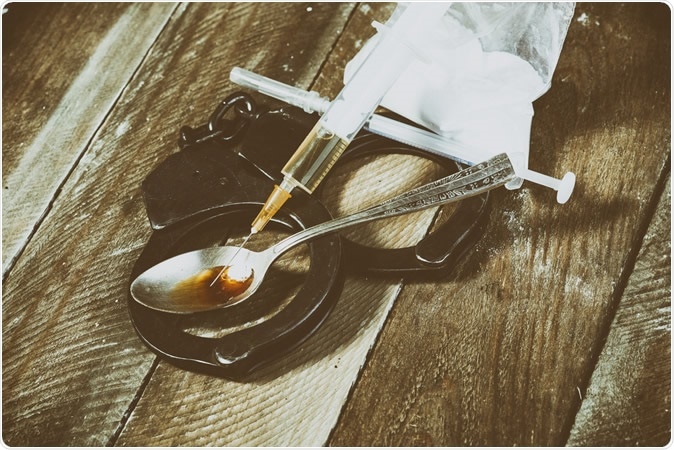The incidence of unintentional overdose leading to death is still going up in Australia, says Australia’s Annual Overdose Report 2019. Most of the drugs involved are very powerful. They include prescription opioids and benzodiazepines as well as illegal substances like heroin and crystal methamphetamine or “ice”. Even worse, more of these deaths are due to the use of multiple (four or more) substances, such as ice with alcohol, which increases the chance of overdosing, compared to death following single-drug overdose. This marks the beginning of a sinister new trend.

Australia’s Annual Overdose Report 2019 reveals that unintentional overdose continues to be a significant cause of death in Australia. Image Credit: Piotr Latacha / Shutterstock
In 2017, there were almost 2,200 deaths due to drug use, compared to only 1200 in 2002 – a rise of 75% in 15 years. Of these, over 1,600 were unintentional, compared to 903 in 2002, amounting to almost 75% of the total in both years. In other words, three out of four people dying of drug overdose do not plan to die that way.
With opioids causing over 900 deaths in 2017, up from 338 in 2006, this category accounts for over half of all unintentional deaths. For the first time, heroin is causing more deaths than with the next group, comprising oxycodone, morphine and codeine. This is the first time heroin has caused more opioid-associated unintentional overdose death than prescription drugs in a decade. This number has more than doubled, from about 150 to almost 360.
Many of the additional deaths from unintentional overdose come from the three-fold increase in stimulant use-associated deaths, from below 160 to well over 400. However, depressants, specifically the benzodiazepines, caused 128% more deaths in 2017, from 256 to 583. Cannabis is still innocent of overdose-related deaths, thankfully. 445 deaths resulted from using four or more drugs together.
More deaths due to accidental overdose occur in regional Australia compared to the big cities, with an absolute increase of 1/100,000 from the latter (6.3/100,000) to the former. The corresponding rate for aboriginals and other native people is a shocking 19.2/100, 000, compared to 6.2 for non-aboriginals. Western Australia has the highest rate of accidental overdose deaths, also topping the charts for deaths from both opioids and stimulants.
Income and education showed no glaring inequalities, with about 23% of deaths occurring in the poorest suburban populations and 19% from the richest.
The worst-affected are those in their middle age, that is, between 30 and 59 years, where 70% of all such deaths occurred. Heroin takes its greatest toll on those between 30 and 39 years, but prescription opioid-associated overdose deaths affect people between 40-49 years more often. Men die more than twice as often as women of unintentional overdose, but both are dying at higher rates than before.
What can we learn?
The chief executive of the Penington Institute, John Ryan, pointed out that in the last decade (2008-2017), almost twice as many people died in Australia following drug overdose as from car accidents. He points out that currently more deaths are beginning to come from illegal substances (like heroin) than from legally available substances (prescription opioids) in the same group. “We're careening down a similar path as America, about seven years ago,” he explains. “Reducing access to prescription drugs without addressing the underlying causes simply changes the type of drugs that are abused – with fatal consequences.”
He is referring to genuine needs for pain palliation and anxiety-alleviating drugs, which must be satisfied. This cannot occur if the authorities merely clamp down on potentially addictive substances without providing adequate alternatives. Ryan comments: “As the police would say: you can't arrest your way out of this problem.”
Secondly, he says, prescribing needs to be monitored more vigilantly, as this still accounts for more overdose deaths rather than illicit drug use. This was underlined by Amy Peacock of the National Drug and Alcohol Research Centre, who says heroin use continues to be low but stable. The increased deaths are due to a bigger population over time. Thus, she says, “The majority of opioid-induced deaths continue to involve pharmaceutical opioids only.”
The answer, says John Ryan, is education and access to drug treatment facilities. People need to understand the dangers of drug use and especially of combining drugs, as well as the signs of a drug overdose. Education about responding to an overdose properly is also, critically, lacking, as is access to the opioid antidote, naloxone.
Paul Dessauer, who works with the Western Australia branch of the organization Peer Based Harm Reduction, says, “We can’t possibly talk to everyone in the state of WA who’s using these drugs. But we teach people to teach others [how to respond to drug overdoses].” Peacock concurs: “We need to see better investment in affordable, accessible treatment for all Australians who are experiencing problems as a consequence of drug use.”
The Australian government has already committed funds of $10 million to a pilot program that will focus on making naloxone more available and giving training in its use. The opioid drug codeine has, meanwhile, been moved to a stricter regulated category, and is no longer available over the counter. Real-time reporting of prescription opioids forms part of a $16 million regulatory model due to roll out in 2020, to identify multiple buys of dangerous prescription-only drugs by the same patient from different sources.